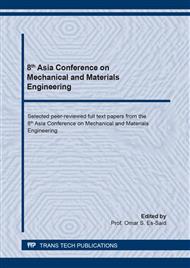[1]
Suárez R, Sertucha J. Materiales inorgánicos aplicados en la fabricación de piezas de fundición. An La Real Soc Española Química 2005:17–27.
DOI: 10.3989/revmetalm.1253
Google Scholar
[2]
Hackney P, Wooldridge R. Optimisation of Additive Manufactured Sand Printed Mould Material for Aluminium Castings. Procedia Manuf 2017;11:457–65.
DOI: 10.1016/j.promfg.2017.07.136
Google Scholar
[3]
Moskowitz D, Humenik M. Modern developments in PM. vol. 3. NY: Plenum Press; (1966).
Google Scholar
[4]
Toguri JM, Themelis NJ, Jennings PH. A review of recent studies on copper smelting. Can Metall Q 1964;3:197–220.
DOI: 10.1179/cmq.1964.3.3.197
Google Scholar
[5]
Beri N, Maheshwari S, Sharma C, Kumar A. Technological advancement in electrical discharge machining with powder metallurgy processed electrodes: A review. Mater Manuf Process 2010;25:1186–97.
DOI: 10.1080/10426914.2010.512647
Google Scholar
[6]
Sithole C, Nyembwe K, Olubambi P. Process knowledge for improving quality in sand casting foundries: A literature review. Procedia Manuf 2019;35:356–60.
DOI: 10.1016/j.promfg.2019.05.052
Google Scholar
[7]
Brown JR. Sand casting processes. Foseco Non-Ferrous Foundryman's Handb 1999:135–48.
DOI: 10.1016/b978-075064286-6/50012-7
Google Scholar
[8]
Almaghariz ES, Conner BP, Lenner L, Gullapalli R, Manogharan GP, Lamoncha B, et al. Quantifying the Role of Part Design Complexity in Using 3D Sand Printing for Molds and Cores. Int J Met 2016;10:240–52.
DOI: 10.1007/s40962-016-0027-5
Google Scholar
[9]
Swift KG, Booker JD. Casting Processes. (2013).
Google Scholar
[10]
Rajkolhe R, Khan JG, Professor A. Defects, Causes and Their Remedies in Casting Process: A Review. Int J Res Advent Technol 2014;2:2321–9637.
Google Scholar
[11]
German RM. Powder metallurgy and particulate materials processing: the processes, materials, products, properties and applications. New Jersey: Metal Powder Industries Federation; (2005).
Google Scholar
[12]
Thursfield G, Stowell MJ. Mechanical properties of Al-8 wt% Fe-based alloys prepared by rapid quenching from the liquid state. J Mater Sci Vol 1974;9:1644–60.
DOI: 10.1007/bf00540763
Google Scholar
[13]
Pickens JR. Aluminium powder metallurgy technology for high-strength applications. J Mater Sci 1981;16:1437–57.
DOI: 10.1007/bf02396863
Google Scholar
[14]
Wadsworth J, Froes FH. Developments in metallic materials for aerospace applications. JOM 1989;41:12–9.
DOI: 10.1007/bf03220217
Google Scholar
[15]
Serrano Santamaría F. Comportamiento en servicio de aleaciones de Titanio obtenidas por pulvimetalurgia. Valladoilid, Spain: (2018).
Google Scholar
[16]
Cristofolini L, Szczepanowicz K, Orsi D, Rimoldi T, Albertini F, Warszynski P. Hybrid Polyelectrolyte/Fe3O4 Nanocapsules for Hyperthermia Applications. ACS Appl Mater Interfaces n.d.;8:25043–50.
DOI: 10.1021/acsami.6b05917
Google Scholar
[17]
Kadir MIA, Mustapa MS, Latif NA, Mahdi AS. Microstructural Analysis and Mechanical Properties of Direct Recycling Aluminium Chips AA6061/Al Powder Fabricated by Uniaxial Cold Compaction Technique. Procedia Eng., vol. 184, Elsevier Ltd; 2017, p.687–94.
DOI: 10.1016/j.proeng.2017.04.141
Google Scholar
[18]
Garg P, Jamwal A, Kumar D, Sadasivuni KK, Hussain CM, Gupta P. Advance research progresses in aluminium matrix composites: manufacturing & applications. J Mater Res Technol 2019;8:4924–39.
DOI: 10.1016/j.jmrt.2019.06.028
Google Scholar
[19]
Chouhan T, Chouhan H, Soni M. High Strain Rate Behavior of Aluminum Produced by Powder Metallurgy. Procedia Struct Integr 2019;14:883–90.
DOI: 10.1016/j.prostr.2019.07.067
Google Scholar
[20]
Bahador A, Hamzah E, Kondoh K, Abubakar T, Yusof F, Saud SN, et al. Defocusing Effects of Laser Beam on the Weldability of Powder Metallurgy Ti-Based Shape Memory Alloys. Procedia Eng., vol. 184, Elsevier Ltd; 2017, p.205–13.
DOI: 10.1016/j.proeng.2017.04.087
Google Scholar
[21]
Espín S. Obtención de piezas metálicas mediante la pulvimetalurgia. Investig y Desarro 2013;6:49–55.
Google Scholar
[22]
Garrido A, Sanchez V. Determinacion de la metodologia para la obtencion de aleaciones de aluminio de fundicion maquinables sin porosidades. (2011).
Google Scholar
[23]
Paraskevas D, Vanmeensel K, Vleugels J, Dewulf W, Duflou JR. The use of Spark Plasma Sintering to fabricate a two-phase material from blended aluminium alloy scrap and gas atomized powder. Procedia CIRP, vol. 26, Elsevier B.V.; 2015, p.455–60.
DOI: 10.1016/j.procir.2014.07.074
Google Scholar
[24]
Arif S, Jamil B, Naim Shaikh MB, Aziz T, Ansari AH, Khan M. Characterization of surface morphology, wear performance and modelling of graphite reinforced aluminium hybrid composites. Eng Sci Technol an Int J (2019).
DOI: 10.1016/j.jestch.2019.07.001
Google Scholar
[25]
M Q, FH F. Titanium powder metallurgy: science, technology and applications. (2015).
Google Scholar
[26]
Ramachandra M, Abhishek A, Siddeshwar P, Bharathi V. Hardness and Wear Resistance of ZrO2 Nano Particle Reinforced Al Nanocomposites Produced by Powder Metallurgy. Procedia Mater Sci 2015;10:212–9.
DOI: 10.1016/j.mspro.2015.06.043
Google Scholar
[27]
Pickens JR. Aluminium powder metallurgy technology for high-strength applications. J Mater Sci 1981;16:1437–57.
DOI: 10.1007/bf02396863
Google Scholar
[28]
Singh N, Parkash O, Kumar D. Phase evolution, mechanical and corrosion behavior of Fe(100-x) Ni(x) alloys synthesized by powder metallurgy. J Phys Chem Solids 2018;114:8–20.
DOI: 10.1016/j.jpcs.2017.10.045
Google Scholar
[29]
Sutjipto AGE, Ti LK, Asmara YP, Legowo A. Sample Preparation of TiO2 Added ZnO Using Powder Metallurgy Route and its Characteristics | Scientific.Net. Mater Sci Forum 2020;981:78–83.
DOI: 10.4028/www.scientific.net/msf.981.78
Google Scholar
[30]
Joshua KJ, Vijay SJ, Ramkumar P, Mohanasundaram S. Effect of ZnO Particles on Microstructure, Microhardness and Wear Behaviour of AA7068 Metal Matrix Composites Synthesized by Powder Metallurgy | Scientific.Net. Mater Sci Forum 2020;979:68–73.
DOI: 10.4028/www.scientific.net/msf.979.68
Google Scholar
[31]
Wang TG, Liu XY, Hua JJ. I. Investigation on the Fabrication and Properties of the Cu Base Friction Composites | Scientific.Net. Mater Sci Forum 2020;984:125–30.
DOI: 10.4028/www.scientific.net/msf.984.125
Google Scholar


